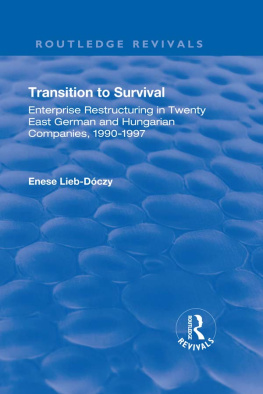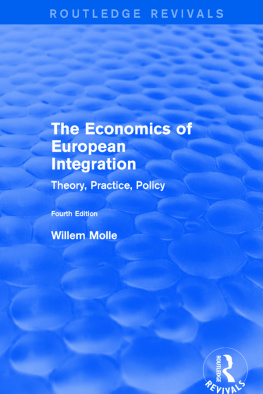Transition to Survival
To my mother, who could light up a room with her smile. A szeretet soha el nem fogy.
First published 2001 by Ashgate Publishing
Reissued 2018 by Routledge
2 Park Square, Milton Park, Abingdon, Oxon OX14 4RN
711 Third Avenue, New York, NY 10017, USA
Routledge is an imprint of the Taylor & Francis Group, an informa business
Copyright Enese Lieb-Dczy 2001
All rights reserved. No part of this book may be reprinted or reproduced or utilised in any form or by any electronic, mechanical, or other means, now known or hereafter invented, including photocopying and recording, or in any information storage or retrieval system, without permission in writing from the publishers.
Notice:
Product or corporate names may be trademarks or registered trademarks, and are used only for identification and explanation without intent to infringe.
Publishers Note
The publisher has gone to great lengths to ensure the quality of this reprint but points out that some imperfections in the original copies may be apparent.
Disclaimer
The publisher has made every effort to trace copyright holders and welcomes correspondence from those they have been unable to contact.
A Library of Congress record exists under LC control number: 00110696
ISBN 13: 978-1-138-73367-1 (hbk)
ISBN 13: 978-1-315-18758-7 (ebk)
Using case studies from twenty East German and Hungarian companies this book examines the process of enterprise restructuring in transition economies. The focus is on the crucial initial restructuring phase of 199097. The broad theme is one of disintegration and integration. The aim is to provide a comprehensive picture of the restructuring process as it affects the crucial aspects of a companys operations. I examine how in response to increasing market pressures companies change their vertical integration, including the in-house provision of social services, how they functionally integrate with their investors and restructure their forward and backward linkages.
A noticeable pattern in my data is that the academic literature and investors frequently endorsed restructuring measures which turned out to be right for the East German companies and wrong for the Hungarian ones. The second startling feature of my case studies is the evidence of total industrial devastation in East Germany. I argue that these observations are related to three recurring themes: local idiosyncrasies matter, the past matters and the future should not be rushed.
This book is the result of a research project which would not have been possible without the cooperation of the over 100 managers interviewed. It is them I have to thank most profoundly for giving up their time for something that yielded little immediate tangible benefits to them. I hope that their openness and intellectual curiosity will contribute to their and their companies future success.
This book was written during my time at the University of Warwick. I thank all the members of the Department of Economics, University of Warwick, for providing me with an excellent working environment and especially Mike Waterson and Morten Hviid for their support and comments on endless versions of this book. Without the financial assistance of the Research Innovation Fund of the University of Warwick, it would have been difficult to complete this research project.
I very much benefited from discussions with colleagues at Warwick and other universities, especially Saul Estrin, Paul Hare, Klaus Meyer, Keith Cowling, Dennis Leach, Aydin Hayri, Bruce Lyons, Gemot Grabher and Csaba Mak. Peter Lankes and Nick Stem at the European Bank of Reconstruction were of great help in negotiating access to Hungarian companies. At a crucial juncture their help was central in making this project happen.
My friends, grown-up and small, provided me with lots of laughter, encouragement and regular reminders of the important things in life. Finally and most importantly, I am indebted to my family, especially my parents and Duncan, for their unshakeable faith and support.
Errors and omissions remain my own.
Enese Lieb-Dczy
NERA, previously University of Warwick
1
Introduction
This book examines the initial restructuring challenges posed by the transition, using comparative case study evidence on the fate of 20 East German and Hungarian enterprises between 1990 and 1997. The broad theme is one of disintegration and integration. I examine how in response to increasing market pressures companies change their vertical integration, including the in-house provision of social services, how they functionally integrate with their investors and restructure their forward and backward linkages. Enterprise restructuring in transition economies is an extraordinary economic and historical occurrence. This process is not only interesting in its own right, but also poses a multitude of academic, policy and practical challenges.
The aim is to provide a comprehensive picture of the restructuring process as it affects the crucial aspects of a companys operations. Transition economics still suffers from data scarcity, particularly when questions at the company-level are concerned. Especially in the early transition phase this scarcity has arguably contributed to the dogmatism based on preconceptions, which is occasionally evident in the academic literature. This book aims to make a contribution by providing detailed empirical evidence which will help in distinguishing the relevant theories and interpretations from the less relevant ones. In doing so this study benefits from a relatively large number of in-depth comparative case studies enjoying an unusual amount of consistency. Only one researcher was involved who spoke each interviewees native language and used the same extensive questionnaire throughout.
provides some of the flesh, the soft tissue, for which subsequent chapters try to provide the organising structure, the bones.
examines the way in which previously highly integrated enterprises have restructured their vertical boundaries. In particular I ask whether, as suggested by the literature on enterprise restructuring, vertical disintegration leads to transaction cost savings and efficiency gains.
maintains a focus on the firms boundaries by examining the way in which enterprises have restructured the extensive social services they used to provide. Empirical hypotheses are examined which suggest that the extent to which a company stops the internal provision of social services is a good indicator of its overall restructuring effort.
deals with the role of foreign direct investors in the strategic restructuring of their subsidiaries. The notion that companies with FDI will outperform their rivals because of knowledge transfer from their investor and his role in introducing new products and production methods is examined both qualitatively and statistically.
Using the literature on economic geography as an interpretative framework deals with the changes which have occurred in the companies forward and backward linkages.
concludes by arguing that in enterprise restructuring local idiosyncrasies matter, the past matters and the future should not be rushed.
Despite the fact that surveys rather than case studies are typically used in economics, case studies play a significant role in other areas of social science. Case studies allow us to focus on naturally occurring units, such as an individual company. By relinquishing typicality, they make possible the thick description of a phenomenon. Case studies allow for an in-depth understanding of context and situation, which is especially important when examining the complex and multifaceted process of adaptation and change companies in transition economies are subject to. Case studies complement surveys because they are able to indicate the qualitative reasons behind statistical regularities, which on their own can be consistent with several explanations or interpretations. In addition the big transition induced changes in the boundaries of firms make the traditional use of large firm databases (even if these were readily available with reliable data) largely irrelevant in the key initial restructuring phase.






